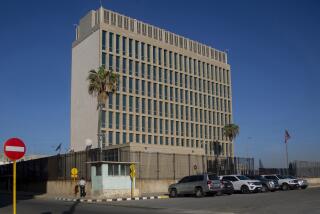Brain imaging could unlock the minds of vegetative patients

For as many as 37,000 Americans who languish in hospital beds across the country unable to speak or respond purposefully to their loved ones, a study published this week may help reveal whether a meaningful mental life lies locked within.
And for patients who retain such cognitive function despite grievous brain injury and years of silence, the techniques described in the new research promise to pry open long-closed doors of communication.
In two patients diagnosed as minimally conscious and a third as vegetative, a Canadian research team detected evidence of an ability to attend to and follow commands. And in two of those patients - one of whom had evinced no glimmer of awareness for 12 years - the researchers found evidence of an ability to understand and respond to questions that suggested the patients were aware of themselves and their surroundings.
The authors of the study used a brain scanner that detects and pinpoints brain activation, and devised a series of exercises to reveal whether patients who had been unable to respond to physicians at the bedside were capable of purposeful mental activity.
Studies have suggested that as many as 40% of patients who are unresponsive are misdiagnosed. After a stroke, near-drowning, carbon monoxide poisoning or traumatic brain injury, many patients appear unaware of themselves or their surroundings and incapable of attention or purposeful movement. An estimated 9,000 to 37,000 Americans have been diagnosed as either vegetative or minimally conscious, leaving anguished loved ones to wonder whether there may be someone still “in there,” but trapped in a broken body.
A welter of new research is finding evidence that within many unresponsive patients resides a mind more capable than has been supposed. In 2010, a team of scientists in Britain and Belgium found that, in a group of 54 vegetative patients put in a brain scanner, five appeared able to imagine themselves, on command, playing tennis or walking through their childhood home.
For the two patients whose brain scans proved most exciting in the new research, the signs of purposeful attention, awareness and ability to communicate were somewhat ambiguous and not elaborate. Asked yes/no questions about their name and where they were, those patients appeared to answer by showing greater brain activation in response to the correct answer to the question asked.
When the patient was asked whether he was in a supermarket, both men showed far more activity in regions of the brain that process spatial information when they were offered the correct answer, no. When asked whether he was in a hospital, the researchers detected increased activation in both men’s brains when they were offered the correct answer, yes. The incorrect answers did not prompt the same level of activation.
All three brain-injured men appeared able to focus and sustain their attention when asked to engage in a mental counting exercise; their brain activation during such exertions was notably greater than when researchers continued the exercise but instructed the patients to relax.
The researchers’ report on the three patients was published this week online by the journal JAMA Neurology.
The researchers, psychologists Lorina Naci and Adrian M. Owen of Canada’s Western University in London, Ontario, suggested that the exercises in the brain scanner might someday be used to diagnose disorders of consciousness more accurately. They could also identify patients who have the mental wherewithal to engage with their world, and the techniques might be refined to allow them one day to communicate with loved ones and medical staff.
The finding may lead to “a paradigmatic shift such that with the further development of prostheses, these unfortunate patients, as well as other patients with other forms of locked-in syndromes, will be able to open the door to end their isolation,” wrote University of Florida neurologist Dr. Kenneth M. Heilman.







